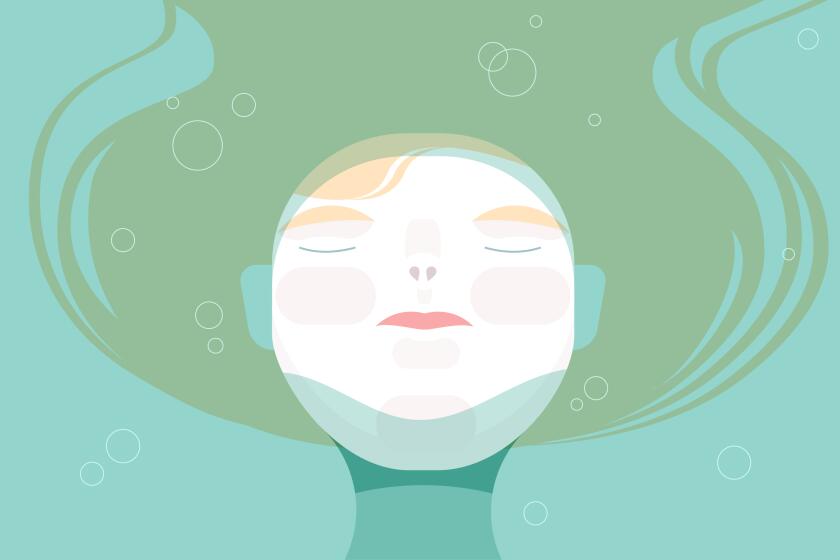
- Share via
Lynn Bufka isn’t sure how she’s going to get through the next nine months.
The licensed psychologist, stress expert and spokesperson for the American Psychological Assn. usually watches the news on TV each morning. But with a contentious presidential election coming up, lately she’s been reluctant to pick up the remote.
“I don’t want to hear anything about the election and it’s only January,” she said in an interview last month. “Even as a psychologist I’m trying to think through how best to manage it.”
Bufka doesn’t want to stick her head under a rock, but she also can’t allow herself to become engulfed in worry about what will happen if her candidate loses. She has a job to do, relationships to maintain and other life responsibilities that demand her attention.
In especially uncertain moments such as these, when her own patients are consumed with anxiety, Bufka recommends compartmentalization — separating different parts of one’s mental and emotional experience.
External and internal ageism permeates our society. Here’s how to step away from the young is good, old is bad dichotomy and embrace getting older.
As questions about our political, environmental and technological future loom, experts say that compartmentalizing can be a useful tool to help us regulate our emotions and face challenges without falling apart. Yes, it’s a defense mechanism that sometimes gets a bad rap, said Gloria Mark, a retired professor of informatics at UC Irvine — but that doesn’t necessarily mean it’s bad for you. “It’s a function that helps us navigate through our days without being burdened by all the stress,” she said.
While it’s possible to over-compartmentalize and, in turn, numb your feelings, taking occasional breaks from intense emotions is an essential component of mental health. We all instinctively do it: We hold back tears to answer an important work call, mute our anger to communicate diplomatically with our partner or push down our anxiety to read a bedtime story to our toddler. In the past decade or so, we as a society may even have developed an increased awareness of this self-preservation technique; Google searches for compartmentalization have been steadily increasing since 2004.
How to get relief without shutting down
Dr. Tara Swart, a neuroscientist and professor at MIT Sloan School of Management, recognizes that the term “compartmentalizing” is loaded. “It gives you the impression that you can take something that is worrying you and lock it in a box and not think about it,” she said. “Actually, no one can do that.”
Instead, Swart says, compartmentalizing can be both good and bad for you. Healthy compartmentalization involves regulating your emotions while unhealthy compartmentalizing means repressing them.
Walt Whitman inspired a former teacher’s fascination with loafing. But where should one loaf in L.A.? These parks are ideal settings for doing nothing alone or with friends.
At its most useful, compartmentalization is the ability to acknowledge challenges in your personal circumstances or current events, and make a conscious decision to not allow those things to take over your thoughts and emotions, she said. But that doesn’t mean shutting out the world.
“The opposite would be to say, ‘I’m not going to read the news,’ ‘I refuse to talk about anything difficult,’ and, ‘Any time I think of something sad and scary I’m just going to push it down,’” she said. “That’s unhealthy.”
There are times when we simply can’t deal with an emotion in the moment. Maybe we have a deadline, or a child to care for, or we’re in the supermarket and it’s not appropriate to cry, scream or yell. In that case, Swart said, we can make an agreement with ourselves that we will make space to sit with it, journal about it or talk about it with a friend or therapist later.
“It’s not easy, and I’m not saying we can do it 100% of the time,” Swart said. “But it’s possible to give yourself some relief from that constant worry.”
How to find intention in withdrawal
Jaz Robbins, a trauma therapist who teaches psychology at Pepperdine University, said the key to healthy compartmentalizing is intentionality.
“I think about people who do social justice work,” she said. “They also have to take a break, to rest and rejuvenate. If they were to say, ‘I won’t rest until I see justice done,’ whatever that metric is, then unfortunately that person may not see rest in their lifetime.”
Advocates and others can allow themselves to relax by being mindful about why they are taking a break from their activism to go out dancing, visit with family or just catch up on the latest season of “The Great British Baking Show.”
Simple strategies for infusing more playfulness, awe and delight into your life.
“To me, compartmentalizing is when an individual exercises a healthy boundary, with intention, in service of a value they hold,” she explained. “That value could be family, health, community, relaxation or even comfort. Comfort is absolutely a value.”
How to build a ‘tolerance toolkit’
Robbins’ patients are already beginning to talk with her about their anxiety over the November election.
“They say, ‘I don’t have the bandwidth for this,’” she said. “And I tell them, ‘You don’t.’ When you get that whisper or inkling that you don’t have the bandwidth for something, you don’t have the bandwidth.”
To help them take even a quick break from their worries, Robbins challenges her patients to build what she calls “a distress tolerance toolkit.” This involves listing five things that make you smile, five that make you laugh, five that inspire you and five that help you relax.
“The idea is to put it together before you need it,” she said. “That way, when the foundation is shaky, you can go to your list and say, ‘I really need a laugh right now.’”
Other strategies to regulate your emotions around a distressing situation include meditation, yoga and exercise, said Swart. She also recommends journaling, talking to a friend or therapist and imagining what advice you would give someone you care about who’s in the same situation. “This allows you to step back and get perspective,” she said.
Bufka, the stress expert, said getting enough sleep is especially important when we’re dealing with stressful situations. “If we don’t have adequate sleep, then we’re less prepared to handle what’s coming our way.”
You know the Koreatown spas. Here are others to get your soak on that draw on traditions of Japanese onsen, Russian banya, Finnish sauna and, yes, the Korean jimjilbang.
She encourages her patients to develop habits that help them relax before bedtime and take their mind off of world events. For her, it’s doing number puzzles like sudoku. For others it might be snuggling with a pet or reading a fantasy or mystery novel.
Bufka also tells people that, just before falling asleep, they might visualize a box and imagine putting all their worries into it — as long as they don’t throw away the key.
“They will still be there when you wake up,” she said.
More to Read
Sign up for The Wild
We’ll help you find the best places to hike, bike and run, as well as the perfect silent spots for meditation and yoga.
You may occasionally receive promotional content from the Los Angeles Times.















